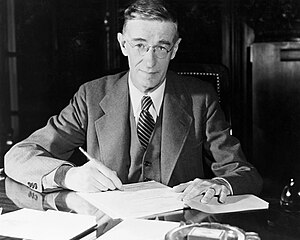Vannevar Bush
Vannevar Bush (/væˈniːvɑːr/ van-NEE-var; March 11, 1890 – June 28, 1974) was an American engineer, inventor and science administrator, who during World War II headed the U.S. Office of Scientific Research and Development (OSRD), through which almost all wartime military R&D was carried out, including initiation and early administration of the Manhattan Project. He is also known in engineering for his work on analog computers, for founding Raytheon, and for the memex, a hypothetical adjustable microfilm viewer with a structure analogous to that of hypertext. In 1945, Bush published the essay "As We May Think" in which he predicted that "wholly new forms of encyclopedias will appear, ready made with a mesh of associative trails running through them, ready to be dropped into the memex and there amplified". The memex influenced generations of computer scientists, who drew inspiration from its vision of the future. He was chiefly responsible for the movement that led to the creation of the National Science Foundation.
For his master's thesis, Bush invented and patented a "profile tracer", a mapping device for assisting surveyors. It was the first of a string of inventions. He joined the Department of Electrical Engineering at Massachusetts Institute of Technology (MIT) in 1919, and founded the company now known as Raytheon in 1922. Starting in 1927, Bush constructed a differential analyzer, an analog computer with some digital components that could solve differential equations with as many as 18 independent variables. An offshoot of the work at MIT by Bush and others was the beginning of digital circuit design theory. Bush became vice president of MIT and dean of the MIT School of Engineering in 1932, and president of the Carnegie Institution of Washington in 1938.
...
Wikipedia

